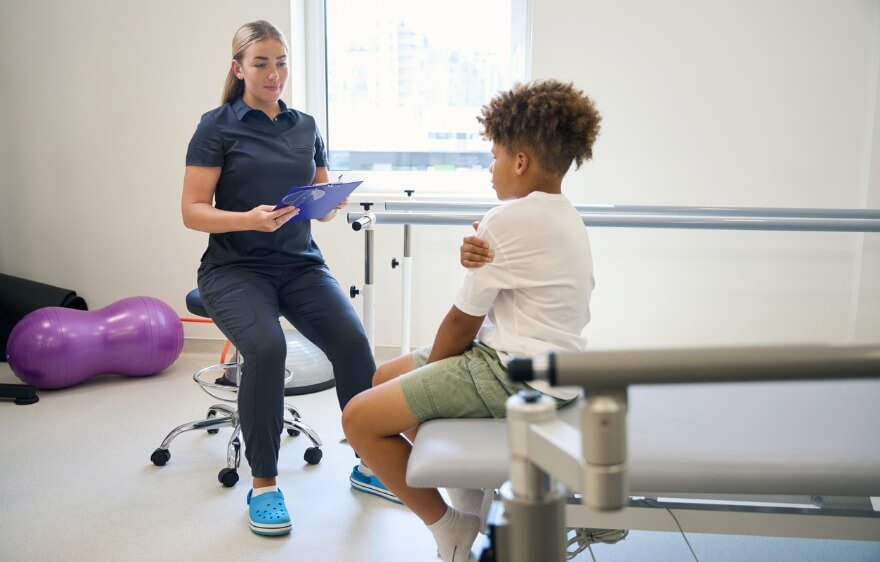When When your child is referred for physical therapy, it’s completely natural to feel a mix of curiosity, concern, and hope. You want what’s best for your child and are seeking answers and support from professionals who understand how to help them grow, move, and thrive. One of the first and most important steps in this journey is the pediatric physical therapy assessment.
In this post, we’ll walk through everything you need to know about what a pediatric physical therapy assessment is, why it matters, what happens during the process, and how to prepare. We’ll also discuss how progress is monitored over time and how parents can support physical therapy efforts at home.
Whether you’re at the very beginning of this path or just looking to better understand the process, this guide is here to give you clarity, reassurance, and practical tools.
Understanding Pediatric Physical Therapy
Pediatric physical therapy is a specialized area of care focused on helping children improve their movement skills and physical abilities. From babies with developmental delays to school-aged children recovering from injuries, pediatric physical therapists are trained to evaluate, treat, and support a wide range of motor-related challenges.
The goal is not only to help children move better but to enhance their participation in everyday activities — whether that’s crawling, walking, jumping, writing, or playing. Therapy may focus on balance, coordination, strength, endurance, flexibility, or motor planning, depending on your child’s specific needs.
Because children are constantly growing and developing, their therapy needs to be tailored to their unique stage of development. This is where a pediatric physical therapy assessment becomes essential.
What Is a Pediatric Physical Therapy Assessment?
A pediatric physical therapy assessment is the first formal step in understanding your child’s current physical abilities, identifying any areas of concern, and designing a plan for intervention. It’s a comprehensive evaluation conducted by a licensed pediatric physical therapist who has expertise in child development and motor function.
Think of the assessment as a foundation. It helps the therapist build a clear picture of how your child moves, what skills they’ve mastered, what challenges they might be facing, and how therapy can best support them. This is not a test your child can “fail.” Rather, it’s a snapshot of where they are right now and where there might be opportunities to help them thrive.
Why Pediatric Physical Therapy Assessments Are Important
Without a proper assessment, it’s nearly impossible to create an effective treatment plan. Every child is different, and what works for one may not work for another. A pediatric physical therapy assessment allows the therapist to tailor their approach, set measurable goals, and track progress over time.
It also helps families understand their child’s strengths and challenges in a clear, supportive way. You’ll receive insights into your child’s motor skills, functional abilities, posture, muscle tone, and more. These findings not only inform therapy but can be valuable in discussions with other healthcare providers, educators, and caregivers.
Early intervention can make a significant difference in a child’s long-term outcomes. An assessment helps catch issues early and provides a path forward.
How to Prepare for Your Child’s First Physical Therapy Appointment
Preparing for a pediatric physical therapy assessment can help you and your child feel more at ease. Here are a few simple steps to get ready:
- Gather relevant medical history: Bring any medical records, developmental history, or reports from previous evaluations. If your child has seen specialists or received a diagnosis, that information is helpful for the therapist.
- Dress comfortably: Have your child wear loose, comfortable clothing that allows them to move freely. Sneakers are usually ideal.
- Bring favorite toys or snacks: These can be useful for helping your child feel more relaxed and engaged during the session.
- Write down your concerns: Before the appointment, jot down any questions or observations about your child’s movement or physical abilities. Sharing your perspective gives the therapist valuable context.
- Be ready to participate: Especially with younger children, therapists often rely on parents or caregivers to provide input and assist with certain parts of the assessment.
Typical Steps in a Pediatric Physical Therapy Assessment
A pediatric physical therapy assessment usually lasts between 45 and 90 minutes, depending on the child’s age, attention span, and specific needs. While every therapist brings their own approach and personality to the session, most evaluations follow a structured process designed to gather a comprehensive picture of a child’s motor development, physical function, and individual challenges.
Here’s a more in-depth look at what you can expect during this essential first appointment:
1. Parent Interview and Developmental History
The assessment typically begins with a parent or caregiver interview. This is a warm, informative conversation where the therapist gathers background information, such as:
- Pregnancy and birth history
- Developmental milestones, such as when your child first rolled over, crawled, stood, or walked
- Medical diagnoses or surgical history
- Feeding, sleeping, and toileting routines
- Family goals or concerns regarding mobility, posture, or daily activities
This discussion helps the therapist understand your child’s journey so far and shape the focus of the evaluation. Your perspective as a parent is essential in identifying what’s working well and what areas may need support.
2. Physical Observation During Natural Play
Next, the therapist will observe your child in a relaxed, natural environment — often through free play, exploration, or interaction with age-appropriate toys. This stage allows the therapist to see how your child moves when they are comfortable and engaged, without structured instruction.
They may look for:
- How your child transitions between positions, such as from sitting to crawling
- Postural alignment when standing or sitting
- Balance and coordination during movement
- Gait patterns — how your child walks or runs
- Interaction with the environment
Observation during play reveals a great deal about a child’s functional motor skills and how they use their body in real-world situations.
3. Guided Movement and Functional Tasks
Once your child is comfortable, the therapist will begin a more structured hands-on evaluation. They’ll ask your child to perform specific movements or tasks to evaluate:
- Muscle strength and tone
- Range of motion in joints
- Endurance and stamina during movement
- Motor planning and body awareness
- Reflex integration
- Balance and weight shifting
These activities may include walking along a line, hopping, climbing stairs, reaching for toys, or crawling through tunnels, depending on your child’s age and skill level. The therapist uses their hands not just to guide movement, but to feel muscle engagement, joint mobility, and response to resistance or support.
4. Postural and Alignment Assessment
In this step, the therapist looks more closely at your child’s alignment, posture, and symmetry. They’ll assess:
- Head, shoulder, and hip positioning
- Spinal alignment
- Foot placement and arches
- Pelvic tilt or rotation
- Asymmetries in muscle development
This part of the pediatric physical therapy assessment helps detect whether imbalances in the body are contributing to delayed or inefficient movement. Addressing posture early can prevent future complications or discomfort as your child grows.
5. Sensory and Neuromuscular Response Testing
Depending on any concerns, the therapist may also explore your child’s sensory integration and neuromuscular responses. This includes evaluating:
- Reaction to touch, pressure, or movement
- Protective reflexes like righting and equilibrium responses
- Proprioceptive awareness, or how well your child understands where their body is in space
- Response to changes in speed or surface underfoot
Children who have sensory processing difficulties may exhibit hesitations, overreactions, or discomfort during certain tasks, and this information helps tailor therapy to their needs.
6. Standardized Developmental Testing
To complement the hands-on assessment, many therapists use standardized tools to objectively measure developmental skills. These tools are age-specific and designed to compare your child’s abilities to established norms. Commonly used assessments include:
- The Peabody Developmental Motor Scales (PDMS-2)
- The Gross Motor Function Measure (GMFM)
- The Bayley Scales of Infant and Toddler Development
- The Bruininks-Oseretsky Test of Motor Proficiency (BOT-2)
These tests are especially valuable for establishing baseline scores, setting therapy goals, and documenting progress over time. They also provide a shared language among healthcare professionals and educators.
7. Parent Debrief and Collaborative Goal Setting
Once the active portion of the pediatric physical therapy assessment is complete, the therapist will sit down with you to review their findings. This is a collaborative conversation, not a one-way report.
The therapist will explain:
- Your child’s strengths and any areas of concern
- Key observations and test results
- How do these findings relate to everyday function and development
- Recommendations for therapy frequency and approach
You’ll have the opportunity to ask questions, share your goals, and talk through any emotional or practical concerns you may have. If appropriate, therapy goals will be written in clear, measurable terms, such as improving balance to prevent falls or increasing leg strength for easier stair climbing.
8. Documentation, Reporting, and Follow-Up Plan
After the session, the therapist will compile a written evaluation report. This document may be shared with your pediatrician, early intervention coordinator, or school team, depending on your child’s situation.
The report will typically include:
- Background information and parent concerns
- Summary of clinical observations
- Scores from standardized testing
- Clinical impressions and diagnosis, if applicable
- Short- and long-term therapy goals
- Recommended frequency and type of intervention
In some cases, the therapist may also offer referrals to other specialists, such as occupational therapy, speech therapy, or orthopedic consultation, if additional support is needed.
Monitoring Progress and Reassessment
Therapy is a journey, not a one-time fix. Once treatment begins, therapists will continually monitor progress through both informal observations and formal reassessments.
Therapists typically use goal-setting tools to measure improvement. For example, a goal might be for your child to walk independently, climb stairs, or improve posture. These goals are specific, measurable, and realistic.
A pediatric physical therapy assessment is not a one-and-done event. Reassessments are scheduled periodically — often every few months — to track progress, adjust the treatment plan, and celebrate milestones. These check-ins are just as important as the initial evaluation because they ensure your child’s therapy remains effective and relevant.
At-Home Pediatric Physical Therapy and Performing Assessments
Therapy doesn’t end when you leave the clinic. In fact, some of the most meaningful progress can happen at home. Many therapists provide exercises, activities, and routines that families can incorporate into daily life.
At-home pediatric therapy allows you to reinforce skills your child is learning in therapy. For example, practicing balance during playtime, encouraging tummy time for babies, or creating obstacle courses for older kids can be both fun and therapeutic.
In addition to exercises, families can support their child’s progress by doing simple at-home check-ins. While these aren’t a substitute for professional assessments, they help you stay connected to your child’s development. Here’s how:
- Watch for changes in movement or posture
- Note improvements in daily activities like dressing, climbing, or playing
- Keep a journal of developmental milestones or new skills
- Use videos to track progress over time
If you notice new challenges or regressions, it’s always a good idea to check in with your therapist. They may recommend another pediatric physical therapy assessment to update the treatment plan.
Physical Therapy for Family Success
A pediatric physical therapy assessment is an important first step in helping your child reach their full physical potential. While it might seem overwhelming at first, the process is designed to be supportive, informative, and empowering for both you and your child.
You’re not alone in this journey. Pediatric physical therapists are not only movement experts — they’re compassionate partners who want to help your child succeed in every way possible.
By understanding what to expect, how to prepare, and how to stay engaged at home, you’ll be better equipped to support your child’s development every step of the way.
If you have concerns about your child’s physical development, don’t wait. Reach out to a pediatric physical therapist and schedule an assessment. The sooner you get started, the sooner your child can begin moving forward — stronger, steadier, and more confidently than ever.
Schedule Your Child’s Care Assessment Today
At Care Options for Kids, we understand the unique challenges of caring for a child with health conditions. Our dedicated team of pediatric home health nurses is here to support your family with compassionate, expert care tailored to your child’s needs. Contact us today to schedule an assessment and learn how we can help you navigate this journey with confidence and care.
Click here to start your journey to better care.
This post is for educational and informational purposes only. You should always speak with your own therapist before implementing this information on your own.






